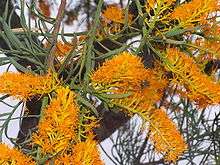Nuytsia
| Nuytsia | |
|---|---|
 | |
| Scientific classification | |
| Kingdom: | Plantae |
| (unranked): | Angiosperms |
| (unranked): | Eudicots |
| (unranked): | Core eudicots |
| Order: | Santalales |
| Family: | Loranthaceae |
| Genus: | Nuytsia R.Br. ex G.Don |
| Species: | N. floribunda |
| Binomial name | |
| Nuytsia floribunda (Labill.) R.Br. ex G.Don[1] | |
| Synonyms | |
| |
Nuytsia floribunda is a hemiparasitic plant found in Western Australia. The species is known locally as the Christmas tree, displaying bright flowers during the Christmas season.
Description
The habit of the species is a tree up to 10 metres (33 ft) high, or as a shrub. The rough bark is grey-brown. Flowers are a vivid yellow-orange, appearing between October and January.
It is a root hemiparasite, is photosynthetic and mainly obtains water and mineral nutrients from its hosts. The haustoria arising from the roots of Nuytsia attach themselves to roots of many nearby plants and draw water and therefore nutrients from them. Almost all species are susceptible to attack; haustoria have even been found attached to underground cables.[2] In natural settings Nuytsia withdraws relatively little from each individual host, but is attached to so many other plants that the benefit to this hemiparasitic tree is likely to be considerable.
Taxonomy
The first description of Nuytsia floribunda was published by Jacques Labillardière in his 1805 work Novae Hollandiae Plantarum Specimen, as Loranthus floribundus,[3] the specific epithet describing the profuse flowers he would have observed at Esperance. The botanist Robert Brown published a remark on the species in 1831, giving a new genus name without a formal description. The description was published by George Don using Brown's name Nuytsia,[1] an epithet that commemorates the seventeenth-century Dutch explorer and colonial official Pieter Nuyts.
A member of the Loranthaceae, a family composed almost entirely of epiphytic mistletoes within the Santalales, the genus Nuytsia is monotypic.
Distribution and habitat

Nuytsia floribunda is well known in Southwest Australia, where it is named the Christmas tree, the common name outside of this region is Western Australian Christmas tree. The appearance of abundant flowers in summer is a spectacular display. Although Nuytsia seeds germinate readily and seedlings are easy to grow for a year or two, cultivation of the species to maturity is regarded as difficult, with little success outside of its native habitat. It appears on a variety of soil types throughout Southwest Australia, the distribution of the species extends to the east of the Esperance Plain and to the north on the Geraldton Sandplains.
Nyungar usage
The Nyungar people made use of the species during the season Kambarang, around October to early December, obtaining bark to make shields. The gum that exudes from the wound can be collected later, it is sweet and eaten raw.[4]
In Australian media
The description of the flower as the Christmas tree has been long established, and is explained regularly over time.[5][6][7][8][9][10]
See also
- Nuytsia (journal) – The Western Australian Herbarium journal
- Metrosideros excelsa, New Zealand Christmas tree
Notes
- 1 2 "Nuytsia floribunda". Australian Plant Name Index (APNI), IBIS database. Canberra, Australian Capital Territory: Centre for Plant Biodiversity Research, Australian Government. Retrieved 1 December 2014.
- ↑ Calladine, Ainsley; Pate, John S. (2000). "Haustorial structure and functioning of the root hemiparasitic tree Nuytsia floribunda (Labill.) R.Br. and water relationships with its hosts". Annals of Botany. 85 (6): 723–731. doi:10.1006/anbo.2000.1130.
- ↑ "Loranthus floribundus". Australian Plant Name Index (APNI), IBIS database. Canberra, Australian Capital Territory: Centre for Plant Biodiversity Research, Australian Government. Retrieved 1 December 2014.
- ↑ Various authors (1998). Ken Wallace; Janette Huston, eds. Exploring Woodlands with Nyoongars (2 ed.). Department of Conservation and Land Management. p. 41. ISBN 0-7309-6847-2.
- ↑ "Nuytsia Floribunda.". Australian Town and Country Journal. Sydney: National Library of Australia. 12 September 1874. p. 16. Retrieved 1 December 2014.
- ↑ "No. 27 CHRISTMAS TREE (NUYTSIA FLORIBUNDA).". Western Mail. Perth: National Library of Australia. 20 October 1921. p. 30. Retrieved 1 December 2014.
- ↑ "OUR WILDFLOWERS.". The West Australian (Perth, WA : 1879 - 1954). Perth, WA: National Library of Australia. 21 December 1928. p. 8. Retrieved 2 January 2016.
- ↑ "CHRISTMAS FLOWERS.". The West Australian. Perth: National Library of Australia. 23 December 1933. p. 18. Retrieved 1 December 2014.
- ↑ "Nuytsia Florabunda.". Western Mail. Perth: National Library of Australia. 27 July 1939. p. 20. Retrieved 1 December 2014.
- ↑ "NUYTSIA FLORIBUNDA.". Western Mail. Perth: National Library of Australia. 20 November 1941. p. 49. Retrieved 1 December 2014.
References
- Association of Societies for Growing Australian Plants (ASGAP) Nuytsia floribunda
- "Nuytsia floribunda". FloraBase. Western Australian Government Department of Parks and Wildlife.
- Thomas Göbel: Heilpflanzen gegen Krebs und Psychose, Nuytsia Floribunda und Viscum Album, Betrachtung und Beurteilung zweier polarer Pflanzencharaktere und ihre Anwendungsmöglichkeiten. Verlag Freies Geistesleben, Stuttgart/Germany 2004, ISBN 3-7725-2230-0 (German language)
External links
 Media related to Nuytsia floribunda at Wikimedia Commons
Media related to Nuytsia floribunda at Wikimedia Commons